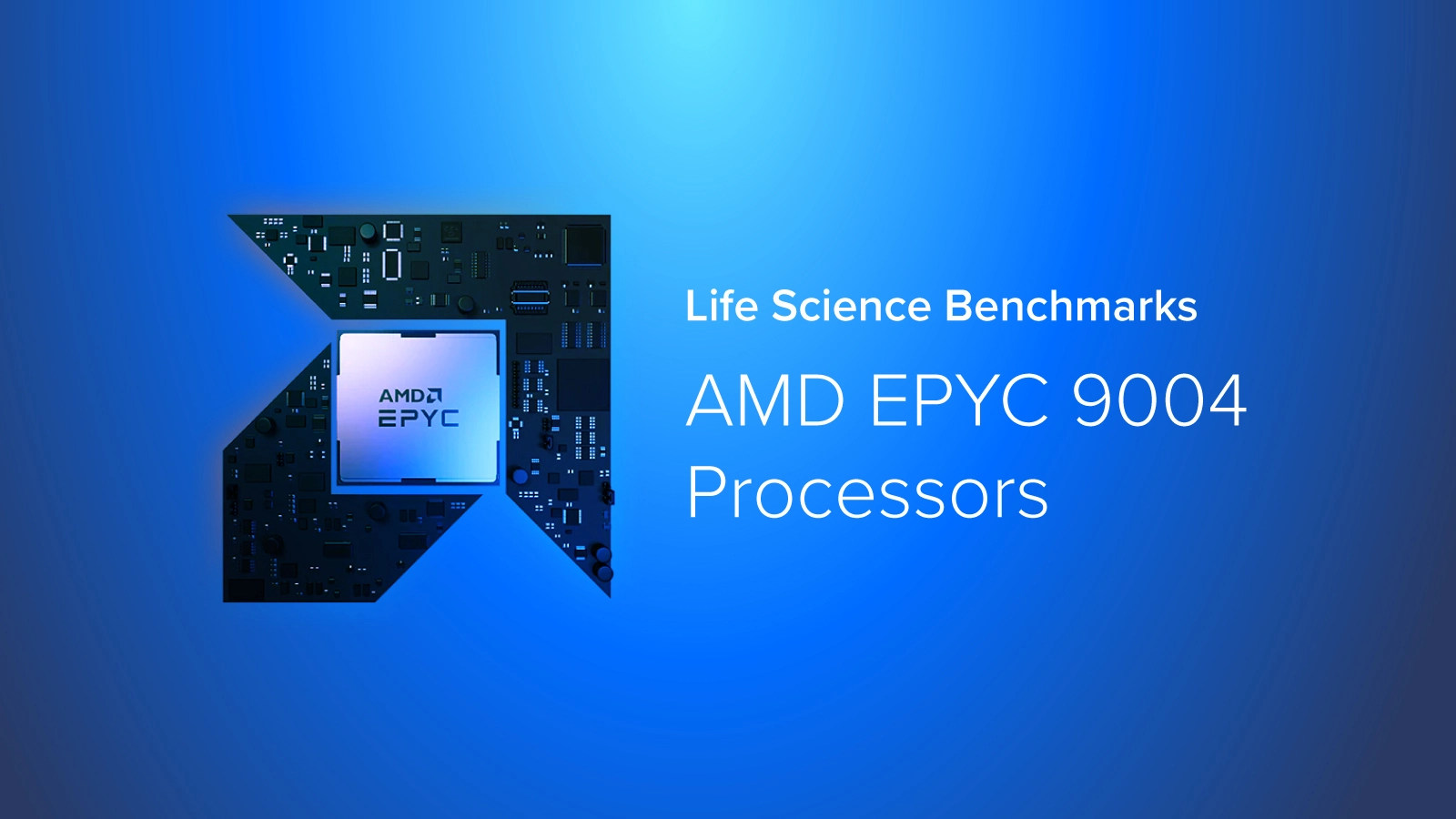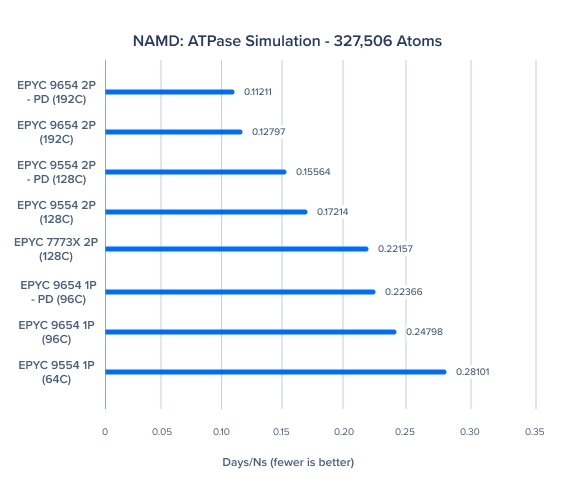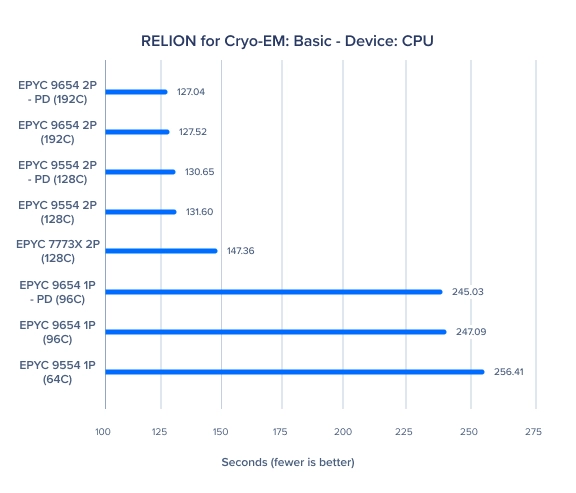
Generational Performance Uplift
AMD is growing in the data center and computing due to its innovation and performance. The 4th Generation EPYC Processors continues to expand its performance leadership as the densest x86 data center CPU to release. While still behind Intel in market share, the growth for AMD has been skyrocketing and its prowess showcases why some high-performance computing infrastructures are opting to make the switch.
Enough about Intel and AMD, we want to see the generation gains from the last generation EPYC and now EPYC 9004. Compared to the last generation flagship EPYC 9004 delivers nearly 2x the performance. The 96 cores in AMD EPYC 9654 not only offer more cores but higher clock speeds and per-core performance for a sizable performance uplift.
AMD EPYC 9004 New Features Background
AMD EPYC 9004 features a power determinism mode that optimizes the power draw for the workload similar to their consumer technology Precision Boost Overdrive (PBO) to throttle more performance if the given cooling and temperatures allow it to surpass its TDP. It also works inversely to protect the CPU from thermal throttling and only increases performance when headroom is available. Power Determinism is only possible because of the acknowledgment that every piece of silicon is unique having higher purity and thus better performance limits.
EPYC's Hybrid architecture uses AMD Zen 4 cores for a 14% increase in instructions per clock as well as the support for DDR5 and PCIe 5. In these benchmarks, the use of DDR5 can increase performance versus DDR4 found in the last generation EPYC 7003.
Don't overlook the advantages AMD EPYC 9004 offers to your data center. Experience EPYC performance for yourself with Exxact servers powered by AMD EPYC 9004.

Life Science Benchmarks
We are featuring our favorite Life Science applications for molecular dynamics and 3D molecule reconstruction in workloads such as GROMACS, NAMD, and RELION. These applications traditionally support the use of GPUs for accelerated performance. However, for purposes of comparing CPUs, we will run these molecular dynamics simulations on the CPU to get a good idea of the performance uplift.
We will distinguish the number of processors (P), power determinism (PD), and total cores (C).
GROMACS: MPI CPU - Input: water_GMX50_bare
The AMD EPYC 9654 2P configuration performed at 1.66x the speed of the last generation 7773X 2P configuration and the 9654 single processor configuration matches it. The uplift in IPC, additional cores, DDR5, and AVX-512 contribute to an AMD EPYC 9004 single processor beating out a dual CPU configuration of their last generation EPYC 7003X flagship with 3D V-Cache. This test shows how generational improvement coupled with automatic boost clocks with Power Determinism enables such high levels of performance; a single EPYC 9564 in Power Determinism mode pulls ahead with a 15% increase over dual 7773X.
NAMD: ATPase Simulation - 327,506 Atoms
With Power Determinism enabled, the EPYC Genoa nearly doubles the last generation’s EPYC 7773X performance numbers, where again a single EPYC Genoa 96C configuration is comparable to a dual 7773X configuration.
RELION for Cryo-EM: Basic - Device: CPU
For our RELION test, the results have changed and the performance gap between Genoa and Milan-X is a little less significant. RELION relies on the number of cores more so than the performance each core provides showing us the previous benchmarks' results of a 96-core unit beating out a 128-core configuration might not always be the case.
However, the results still show us that the EPYC 9554 dual CPU configuration pulled out ahead of the EPYC 7773X by a healthy 12% increase, a familiar performance jump we saw in AMD’s 14% IPC uplift.
Closing Remarks
The performance metrics and increased TDP of AMD's latest CPUs may raise concerns about their efficiency. However, it is evident that the remarkable advancements brought by 4th gen EPYC to high-performance computing outweigh the impact of the TDP increment. The performance of a single AMD EPYC 9654 flagship is outperforming the last generation flagship EPYC 7773X. The ability to consolidate your rack space can prove extremely valuable for customers and system integrators.
Rack space is valuable real estate for computing and the less you have on your racks, the less overhead you have even if per CPU can draw more power.
Have any questions on which AMD EPYC 9004 SKU you should pick? Want to upgrade your infrastructure with rack consolidation in mind?
Contact Exxact today to learn more about your next server powered by AMD EPYC 9004

AMD EPYC 9004 Processors - Life Science Benchmarks
Generational Performance Uplift
AMD is growing in the data center and computing due to its innovation and performance. The 4th Generation EPYC Processors continues to expand its performance leadership as the densest x86 data center CPU to release. While still behind Intel in market share, the growth for AMD has been skyrocketing and its prowess showcases why some high-performance computing infrastructures are opting to make the switch.
Enough about Intel and AMD, we want to see the generation gains from the last generation EPYC and now EPYC 9004. Compared to the last generation flagship EPYC 9004 delivers nearly 2x the performance. The 96 cores in AMD EPYC 9654 not only offer more cores but higher clock speeds and per-core performance for a sizable performance uplift.

AMD EPYC 9004 New Features Background
AMD EPYC 9004 features a power determinism mode that optimizes the power draw for the workload similar to their consumer technology Precision Boost Overdrive (PBO) to throttle more performance if the given cooling and temperatures allow it to surpass its TDP. It also works inversely to protect the CPU from thermal throttling and only increases performance when headroom is available. Power Determinism is only possible because of the acknowledgment that every piece of silicon is unique having higher purity and thus better performance limits.
EPYC's Hybrid architecture uses AMD Zen 4 cores for a 14% increase in instructions per clock as well as the support for DDR5 and PCIe 5. In these benchmarks, the use of DDR5 can increase performance versus DDR4 found in the last generation EPYC 7003.
Don't overlook the advantages AMD EPYC 9004 offers to your data center. Experience EPYC performance for yourself with Exxact servers powered by AMD EPYC 9004.

Life Science Benchmarks
We are featuring our favorite Life Science applications for molecular dynamics and 3D molecule reconstruction in workloads such as GROMACS, NAMD, and RELION. These applications traditionally support the use of GPUs for accelerated performance. However, for purposes of comparing CPUs, we will run these molecular dynamics simulations on the CPU to get a good idea of the performance uplift.
We will distinguish the number of processors (P), power determinism (PD), and total cores (C).
GROMACS: MPI CPU - Input: water_GMX50_bare

The AMD EPYC 9654 2P configuration performed at 1.66x the speed of the last generation 7773X 2P configuration and the 9654 single processor configuration matches it. The uplift in IPC, additional cores, DDR5, and AVX-512 contribute to an AMD EPYC 9004 single processor beating out a dual CPU configuration of their last generation EPYC 7003X flagship with 3D V-Cache. This test shows how generational improvement coupled with automatic boost clocks with Power Determinism enables such high levels of performance; a single EPYC 9564 in Power Determinism mode pulls ahead with a 15% increase over dual 7773X.
NAMD: ATPase Simulation - 327,506 Atoms

With Power Determinism enabled, the EPYC Genoa nearly doubles the last generation’s EPYC 7773X performance numbers, where again a single EPYC Genoa 96C configuration is comparable to a dual 7773X configuration.
RELION for Cryo-EM: Basic - Device: CPU

For our RELION test, the results have changed and the performance gap between Genoa and Milan-X is a little less significant. RELION relies on the number of cores more so than the performance each core provides showing us the previous benchmarks' results of a 96-core unit beating out a 128-core configuration might not always be the case.
However, the results still show us that the EPYC 9554 dual CPU configuration pulled out ahead of the EPYC 7773X by a healthy 12% increase, a familiar performance jump we saw in AMD’s 14% IPC uplift.
Closing Remarks
The performance metrics and increased TDP of AMD's latest CPUs may raise concerns about their efficiency. However, it is evident that the remarkable advancements brought by 4th gen EPYC to high-performance computing outweigh the impact of the TDP increment. The performance of a single AMD EPYC 9654 flagship is outperforming the last generation flagship EPYC 7773X. The ability to consolidate your rack space can prove extremely valuable for customers and system integrators.
Rack space is valuable real estate for computing and the less you have on your racks, the less overhead you have even if per CPU can draw more power.
Have any questions on which AMD EPYC 9004 SKU you should pick? Want to upgrade your infrastructure with rack consolidation in mind?
Contact Exxact today to learn more about your next server powered by AMD EPYC 9004




.jpg?format=webp)